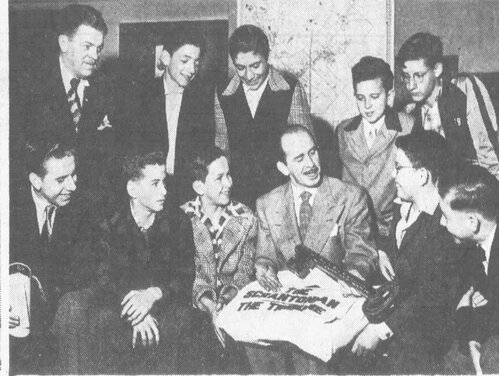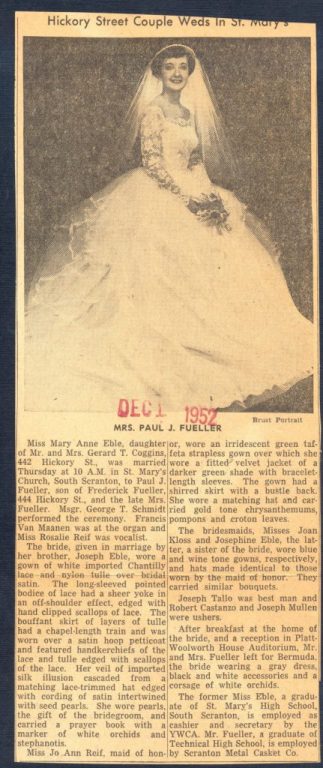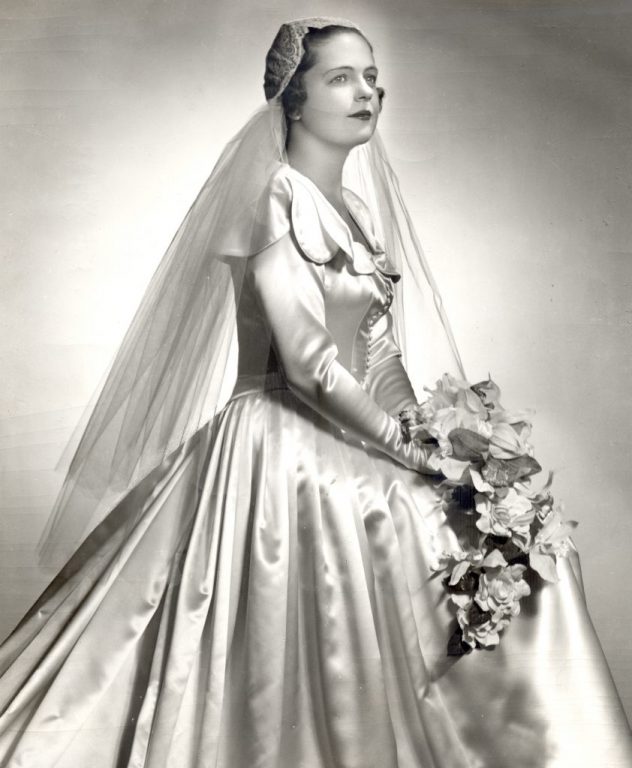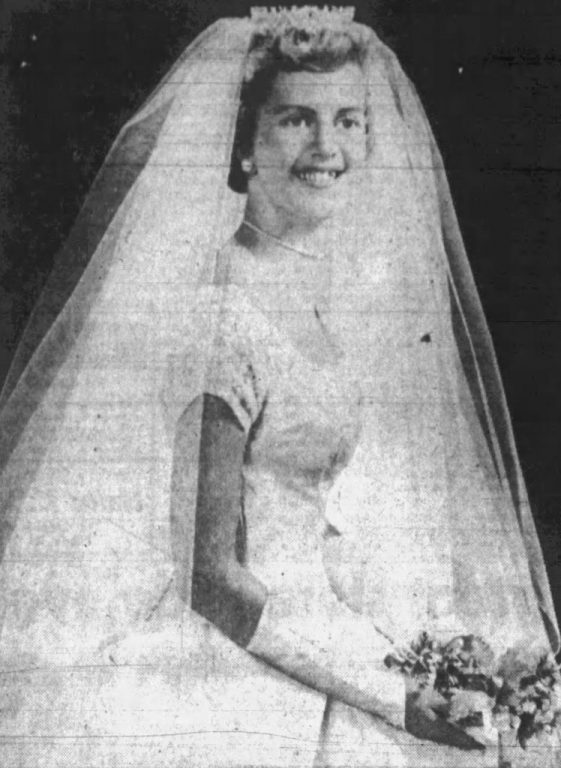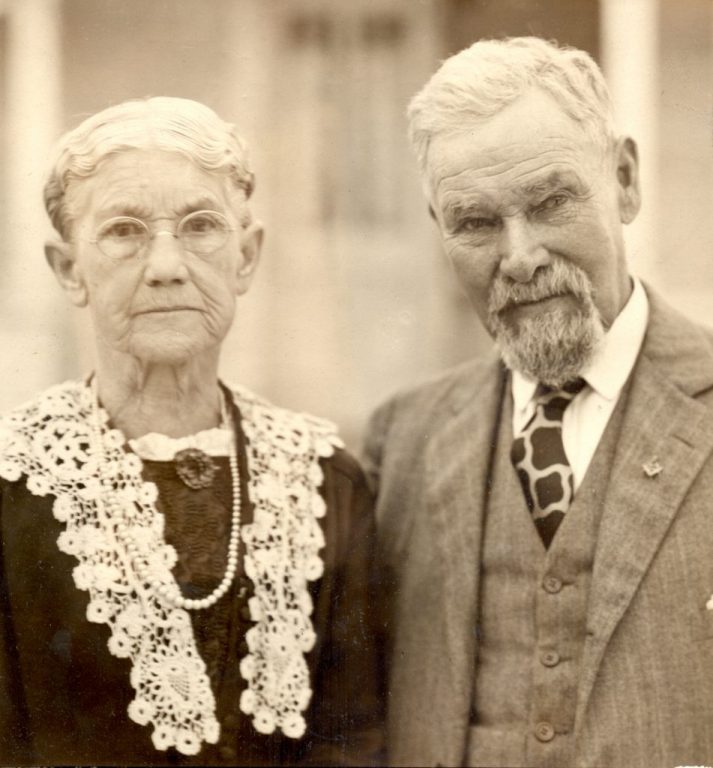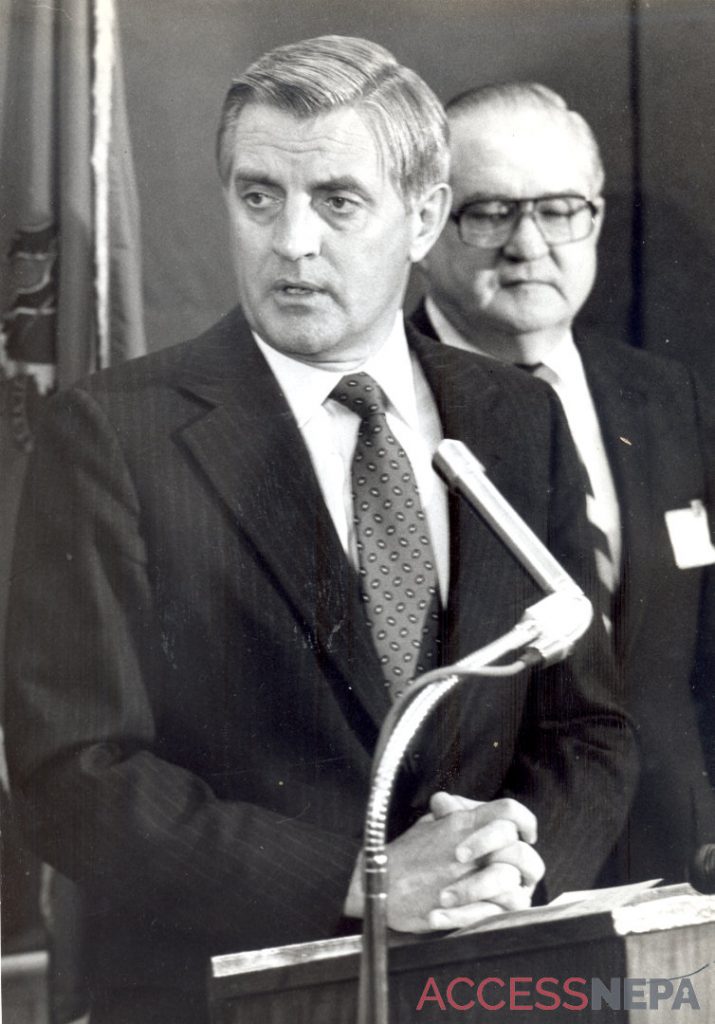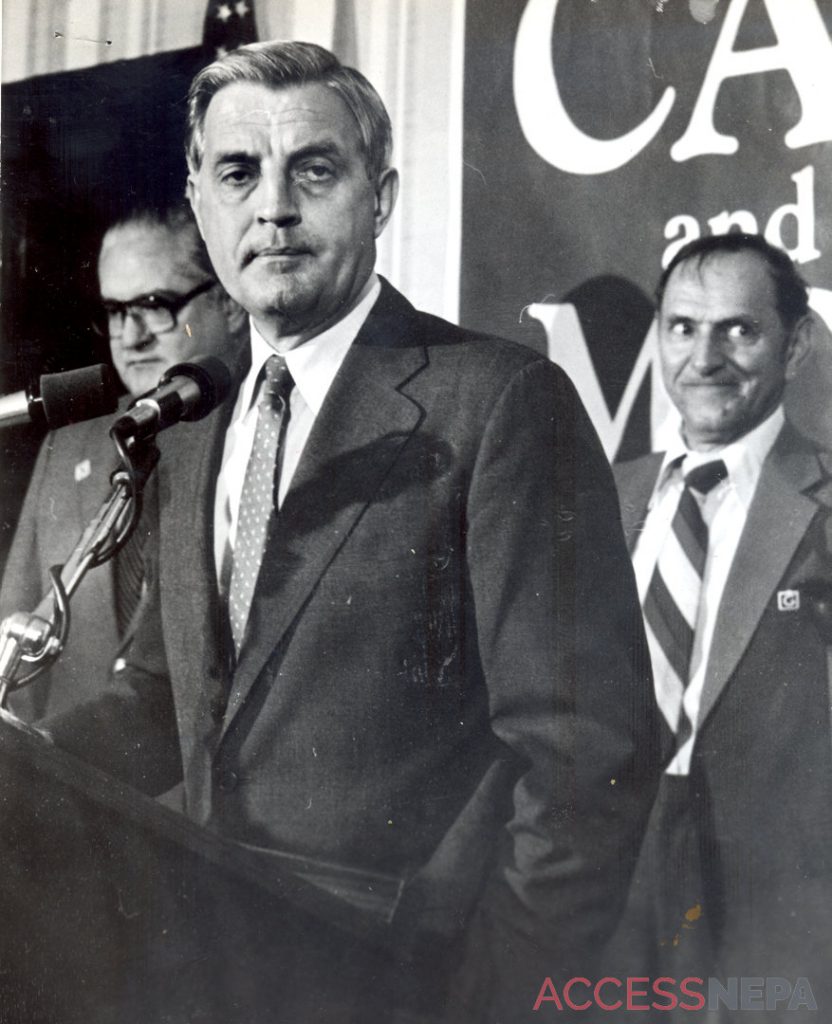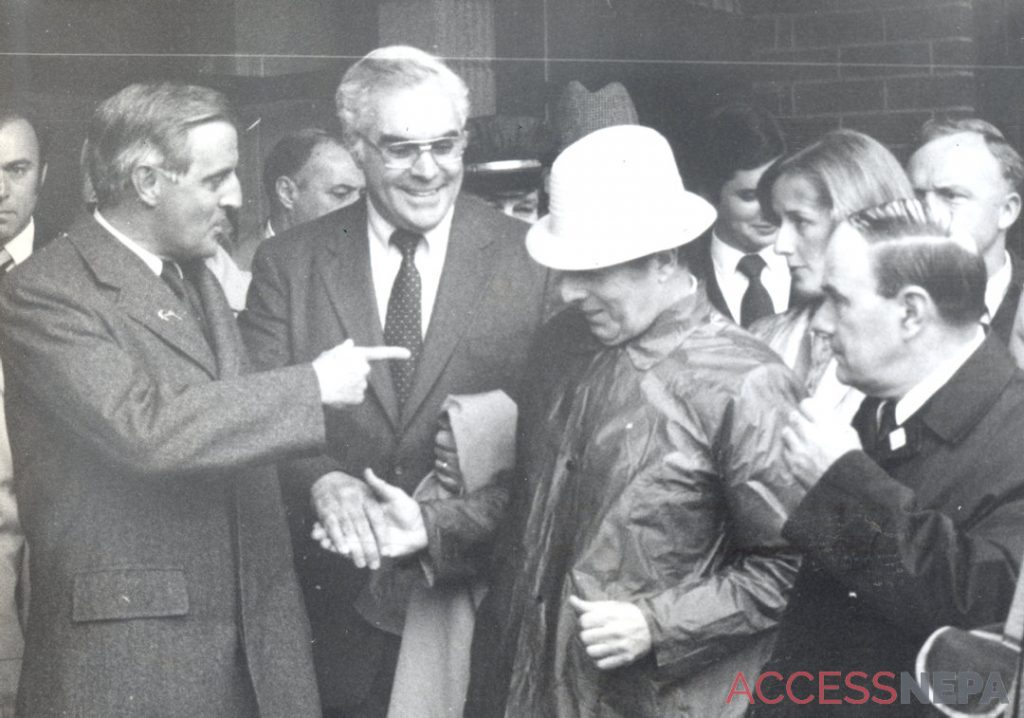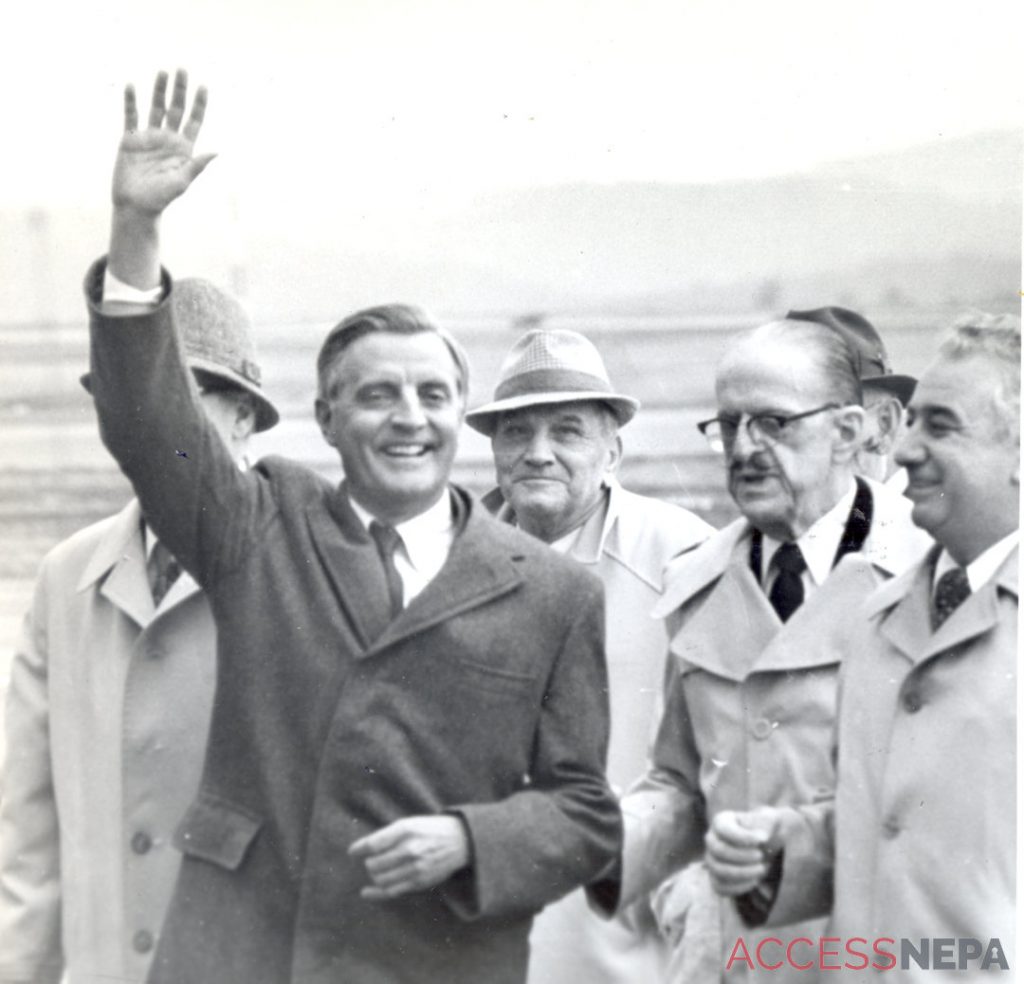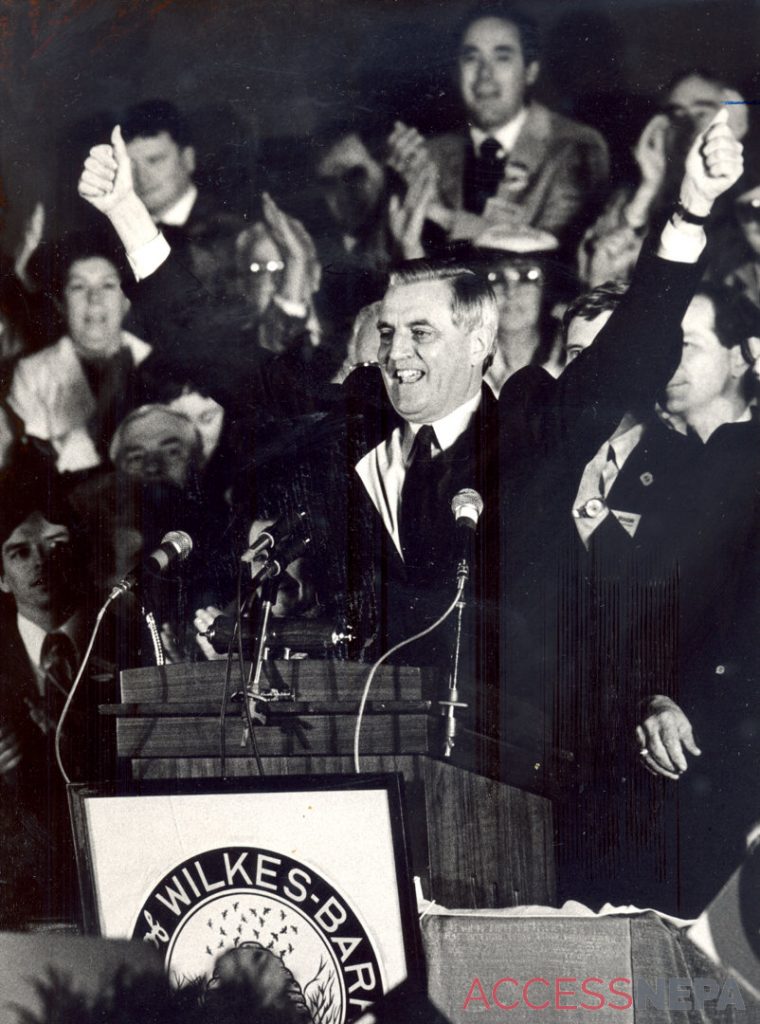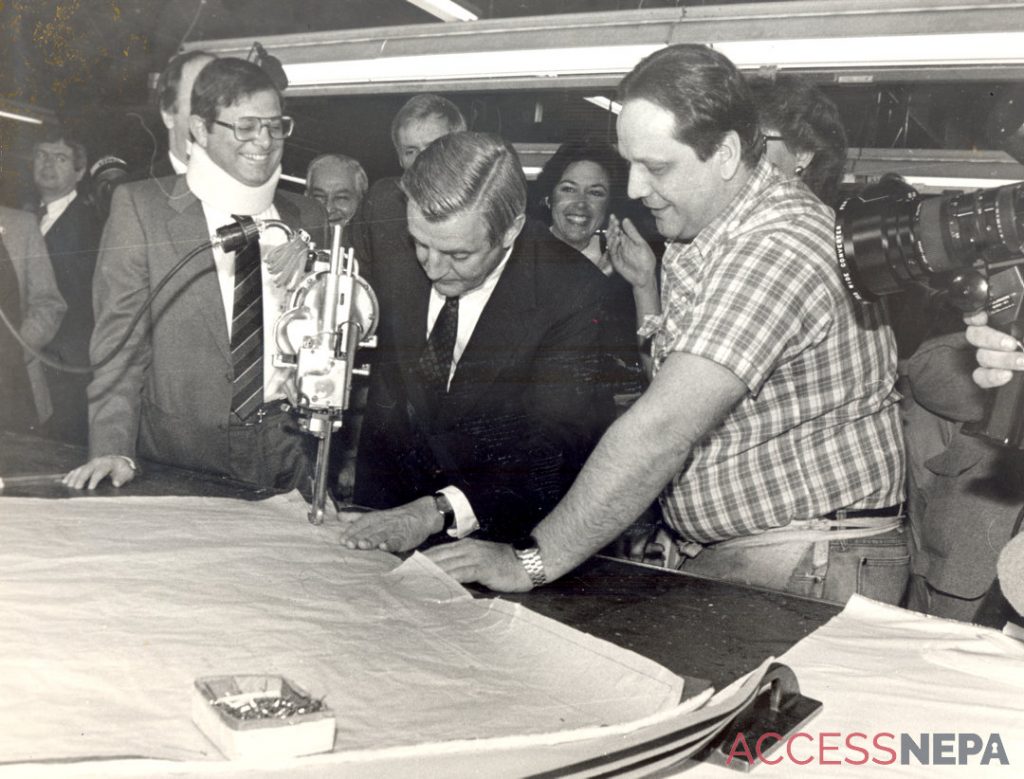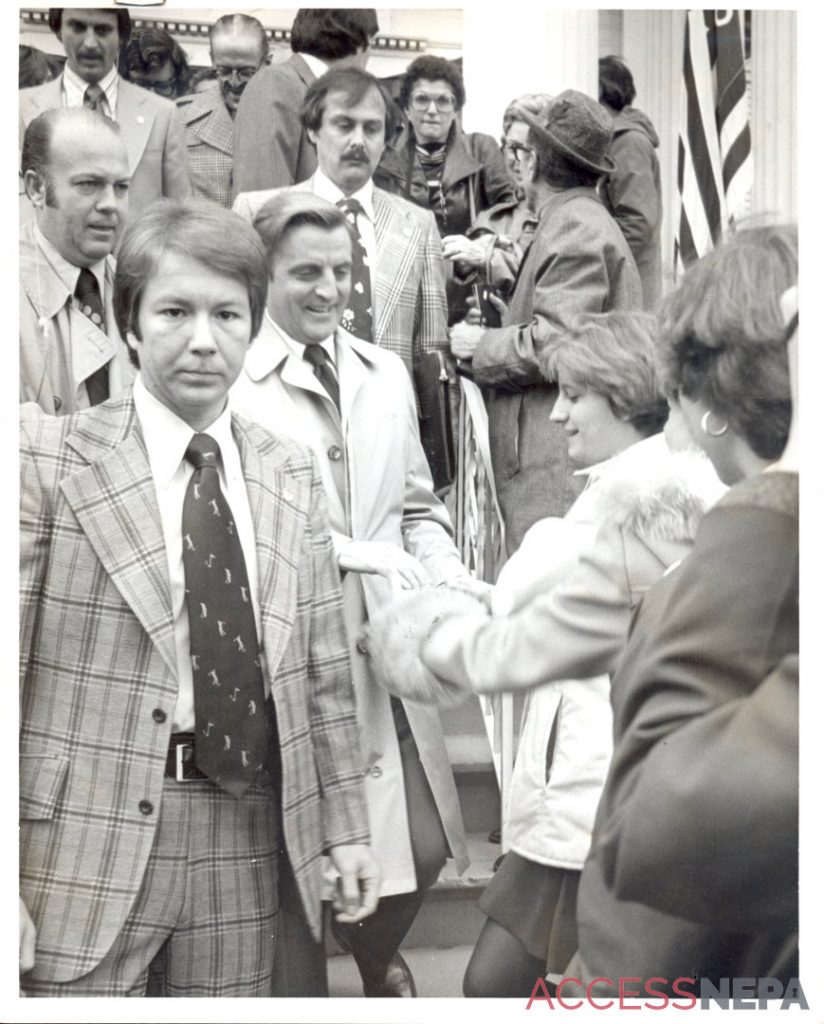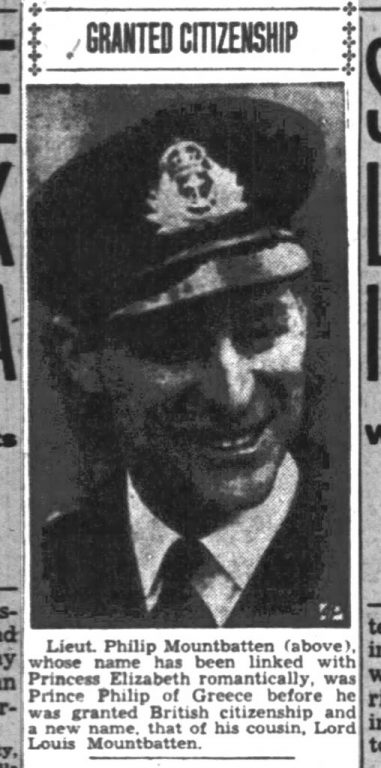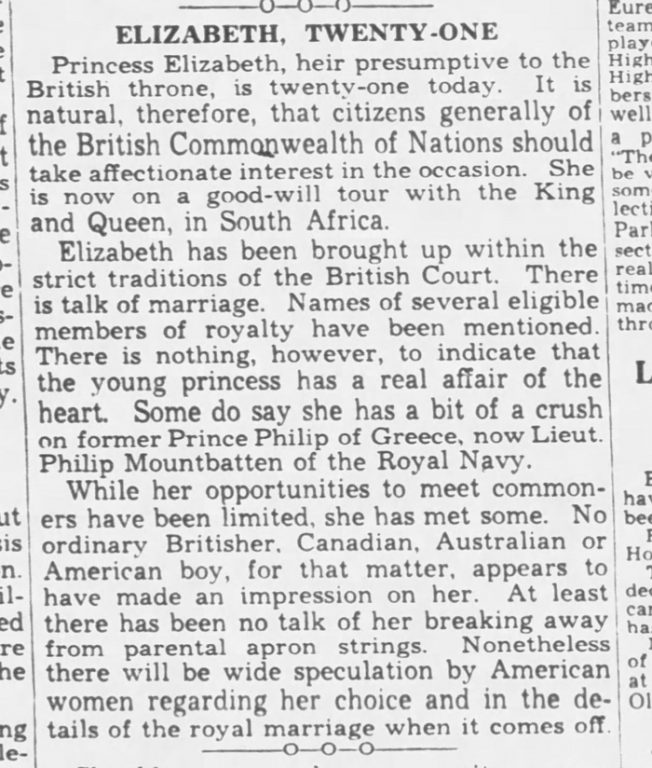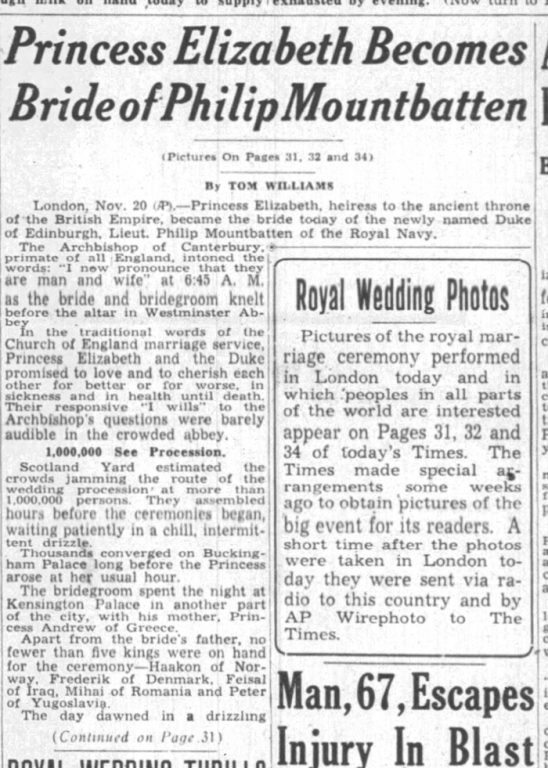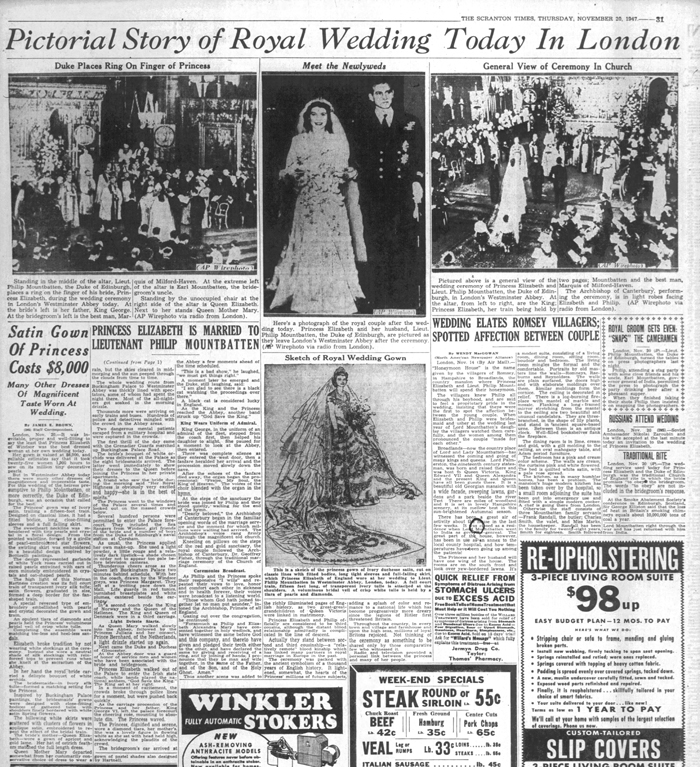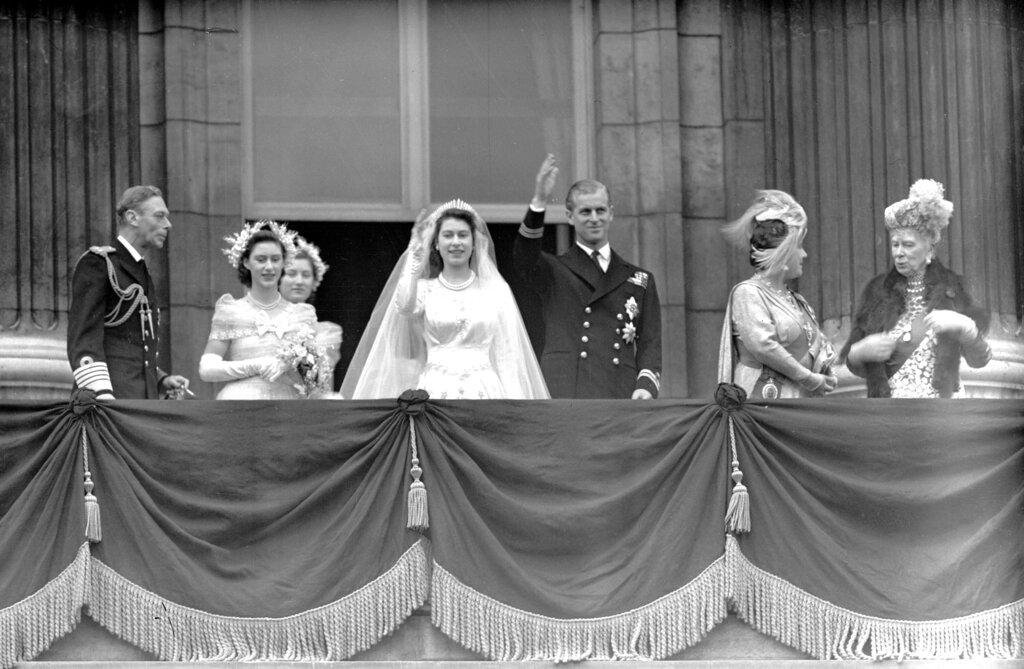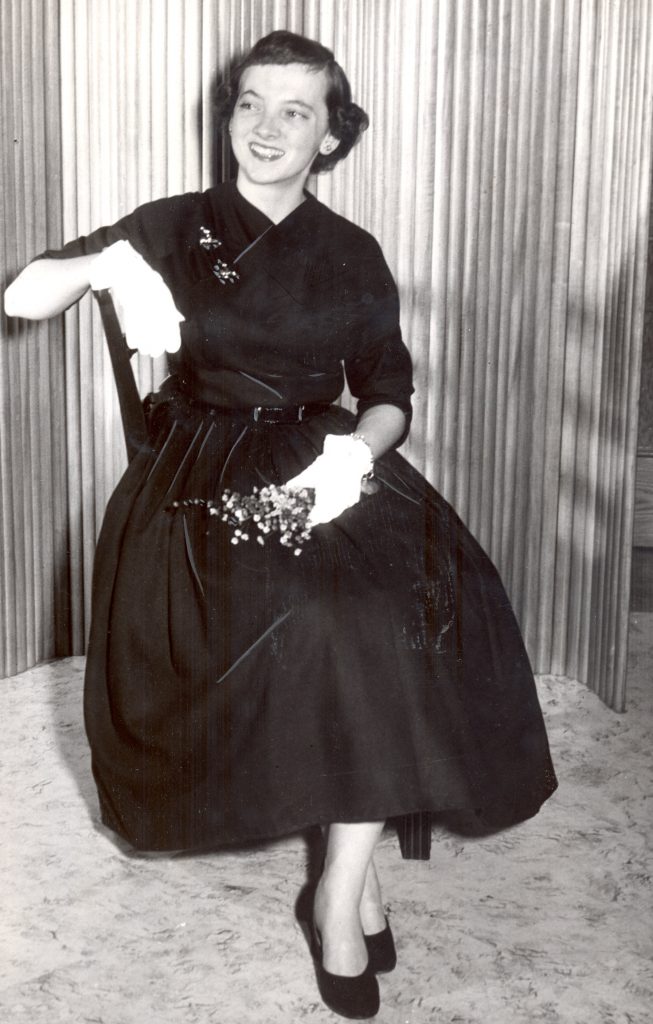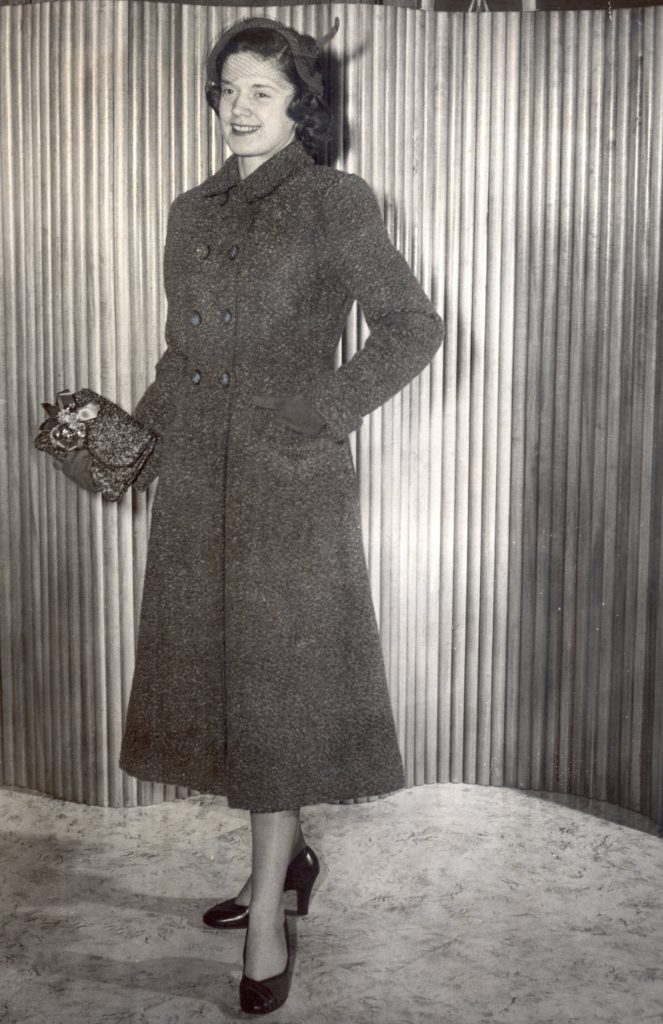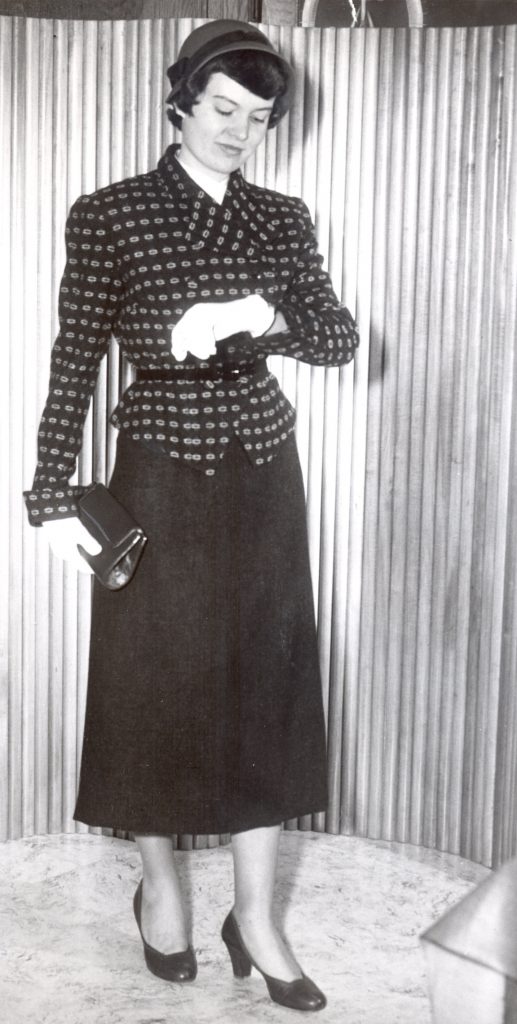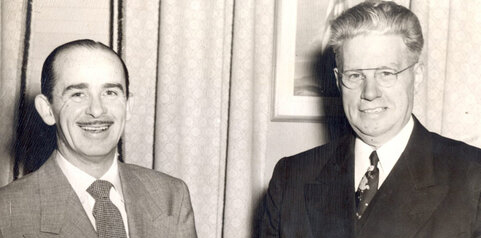
Time Warp – Disney songwriting legend returns to Scranton for hometown events
Editor’s note: In the weeks leading up to the 93rd Academy Awards ceremony on Sunday, April 25, Time Warp will feature stories related to films nominated this year and other local connections to the annual film event.
May 18, 1950: Scranton native and award-winning songwriter Ned Washington came back to his hometown to present his latest work.
At the Strand Theater, Washington introduced the latest film to which he contributed, “My Foolish Heart,” which featured a song of the same name with lyrics by Washington and music by Victor Young. Based on a J.D. Salinger short story, “Uncle Wiggily in Connecticut,” the film starred Susan Hayward and Dana Andrews. It premiered in Los Angeles on Dec. 25, 1949, and had just made it to Scranton several months later.
Before the evening premiere at the Strand, Scranton Mayor James Hanlon presented Washington with the key to the city in a short ceremony at City Hall. Next, Washington, a former Scranton Republican and Scranton Times newsboy, visited the Times newsroom and performed on the “Open House Show” on the Times’ radio station, WQAN.
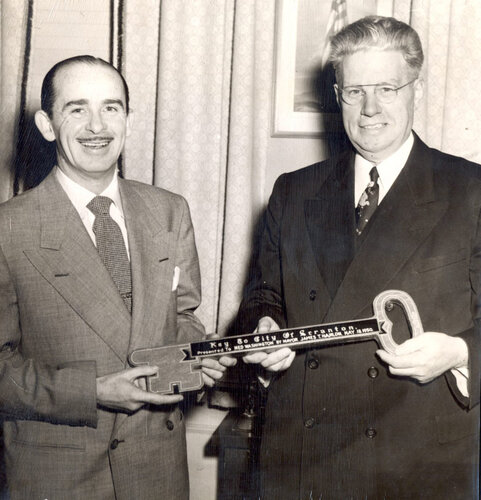
Scranton native Ned Washington, on left, receives the key to the city of Scranton from Mayor James Hanlon on May 18, 1950. TIMES-TRIBUNE ARCHIVES
At the premiere, Washington told the crowd of 1,700, “No matter where you go, how far away, or what you do, there’s always something that pulls your heart back to the place where you were born.”
Washington and Young’s song became a hit and earned them a nomination for best song at the Academy Awards (they lost to Frank Loesser’s “Baby It’s Cold Outside”). But by that time, Washington was pro on the awards scene.
At the Academy Awards for 1940, Washington, along with Leigh Harline and Paul J. Smith, won the Oscar for best score for Walt Disney’s “Pinocchio,” and Washington and Harline won the award for best song for “When You Wish Upon a Star,” which went on to become a Disney legend. Washington and Harline also wrote the lyrics for other songs in Pinocchio, such as “Give a Little Whistle” and “I’ve Got No Strings.”
The following year, Washington was nominated for best song for “Baby Mine,” part of another Disney classic, “Dumbo.” He lost to Jerome Kern and Oscar Hammerstein II for “The Last Time I Saw Paris” from the film “Lady Be Good.”
- Ned Washington, nationally known songwriter and Scranton native, talks to paper boys of the Scranton Tribune on May 18, 1950. In Washington’s youth he worked as newsboy for the Scranton Republican and Scranton Times. Front row: Charles Huffman, Billy Jenkins, Washington, Ralph Canterbury and Donald Hughes. Standing: David J. Thomas, Robert Finch, Ray Sucheski, Joseph Barbuti, Peter Coyer and Ronald Philbin. TIMES-TRIBUNE ARCHIVES
- Special Chamber of Commerce award is given to Ned Washington before a crowd on Strand Theate stage on May 18, 1950. From left: William J. Raeder, Chamber president; Carl Noll, Willis Jones, Chamber general secretary; Washington and Jack Guinan, master of ceremonies. TIMES-TRIBUNE ARCHIVES
A few years later, Washington was nominated for the song “Saludos Amigos” from the Disney animated short of the same name, and then for “Rio De Janeiro” from the film “Brazil.” In 1952, he picked up his third Academy Award for best song for “High Noon (Do Not Forsake Me, Oh My Darlin’)” from the film “High Noon.” He shared the award with Dimitri Tiomkin.
Washington collected several other Oscar nominations for best original song through the years, for “Sadie Thompson’s Song (Blue Pacific Blues)” from “Miss Sadie Thompson” (1953), the title song from “The High and the Mighty” (1954), “Wild Is the Wind” from the film of the same name (1957), “Strange Are the Ways of Love” from “The Young Land” (1959) and “Town Without Pity” from the film of the same name (1961).
Before working in Hollywood, Washington also wrote songs for three Broadway musicals, “Earl Carroll’s Vanities,” “Murder at the Vanities” and “Blackbirds of 1933.”
According to the American Society of Composers, Authors and Publishers database, Washington has more than 500 songwriting credits. He served as its director from 1957 to 1976 and vice president from 1964 to 1976.
Washington died on Dec. 20, 1976, at 75. He was survived by his wife, Patricia; a daughter, Catherine Hinen; two granddaughters and two sisters.
Related –
Time Warp – ‘The Jungle’ puts Sinclair, meatpacking industry in spotlight – April 16, 2021
Time Warp – ‘Chicago 7’ members follow trial with local visits to universities – April 8, 2021
Mankiewicz Brothers leap from Wilkes-Barre into Hollywood history – Dec. 7, 2020
Remembering Louis Weitzenkorn – Jan. 12, 2020
A trio of Ned Washington’s hits –

Brian Fulton has been the librarian at The Times-Tribune for the past 15 years. On his blog, Historically Hip, he writes about the great concerts, plays/musicals and celebrity happenings that have taken place throughout NEPA. He is also the co-host of the local history podcast, Historically Hip. He competed and was crowned grand champion on an episode of NPR quiz show “Ask Me Another.” Contact: bfulton@timesshamrock.com; 570-348-9140; or @TTPagesPast


Throwback Thursday – Remember When Wilkes-Barre had a Wawa
Back in the 90s, Wilkes-Barre had Cafe Metropolis, Palooka’s Diner, Mimmo’s in the Mid-Town Village and a Wawa.
Yes, the popular Southeastern Pennsylvania convenience store chain once operated a food mart in the East End section of the Diamond City.
The exciting news was announced in July 1989 that a Wawa Food Market was coming to Wilkes-Barre. Gary Leone, a real estate representative for Wawa, said in an interview with Citizens’ Voice that “we’re looking for more market share in the Poconos. Wilkes-Barre is a sensible place.” He said the deal should be completed in 30 days.
Leone said the Wawa Food Market will feature “fresh produce, deli and dairy products. Most stores are open 24 hours a day and sell strictly food items. Wawa stores do not sell gasoline.”
A Wawa Food Market was already in operation in Blakeslee.
The Wawa was built at the intersection of Spring Street and North Sherman Street in Wilkes-Barre. The store opened on May 22, 1992.
For the next nine years, the Wawa would offer its hoagies, snacks and dairy products to the people of Wilkes-Barre. But it would all come to an end in August 2001.
Lori Bruce, spokesperson for Wawa, in a Citizens’ Voice article from Aug. 25, 2001 said the company decided to close the Wilkes-Barre location after an “overall review process.” She added “whenever possible, we try to update, expand or modernize our stores rather than close them. But sometimes, that’s not possible.”
Bruce said the Wilkes-Barre location “was not conducive to operate as a convenience market.”


Quick Stop Food Mart at the intersection of Spring St. and N. Sherman St. in Wilkes-Barre. BRIAN FULTON/STAFF PHOTO
The Wawa would close but the building would not stay vacant. The building would become home to a Quick Stop Food Mart. The Quick Stop is still in operation today.
If you are looking for a Wawa fix, here is list of stores in Northeast Pennsylvania –
Blakeslee Corner – Rt 940 and SR 115 in Blakeslee
White Haven – Rt 940 and Pennsylvania Turnpike
Stroudsburg – West Main Street
East Stroudsburg – 207 Prospect Street and 5121 Milford Road
Related –
Time Warp 1979: 7-Elevens’ stay in region short-lived – Jan. 8, 2020










Brian Fulton has been the librarian at The Times-Tribune for the past 15 years. On his blog, Historically Hip, he writes about the great concerts, plays/musicals and celebrity happenings that have taken place throughout NEPA. He is also the co-host of the local history podcast, Historically Hip. He competed and was crowned grand champion on an episode of NPR quiz show “Ask Me Another.” Contact: bfulton@timesshamrock.com; 570-348-9140; or @TTPagesPast
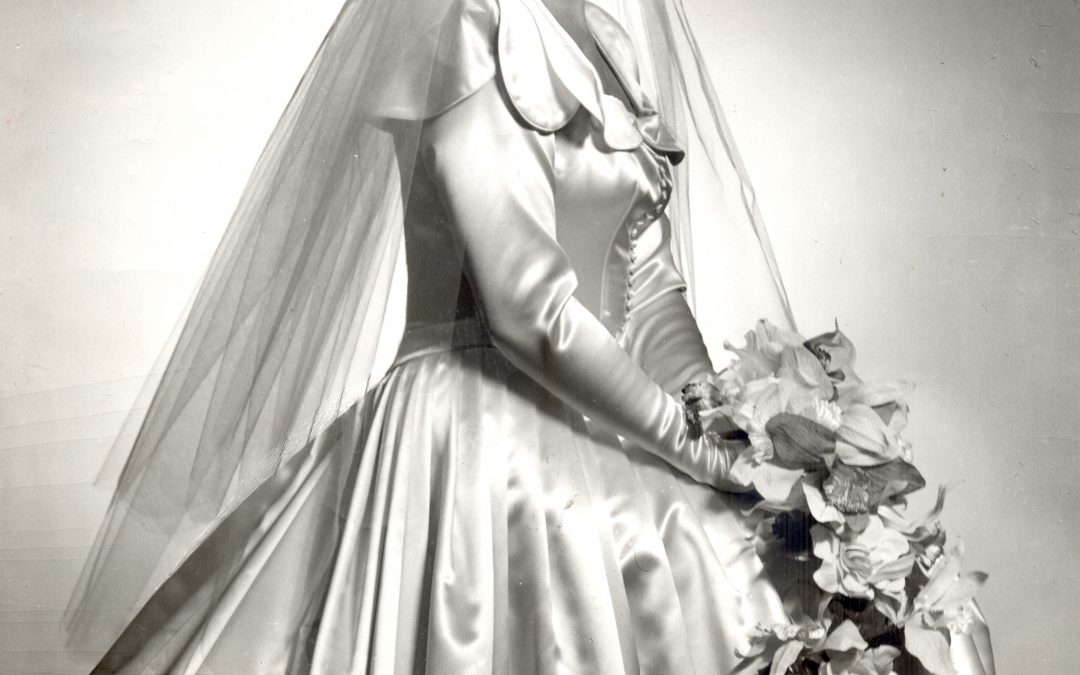

Take a walk back down the aisle
Take a walk back down the aisle as we dig deep into The Sunday Times archives and share timeless matrimonies.
This occasional feature will highlight beautiful brides, engaging moments and captivating ceremonies held decades ago in Northeast Pennsylvania. The Sunday Times’ very own bridal planner of the past, Laura Rysz, will showcase Marry Memories and welcomes suggestions from readers by email at Lrysz@timesshamrock.com.
Mary Anne Eble married Paul J. Fueller on Thursday, Nov. 27, 1952, in St. Mary’s Church, Scranton.
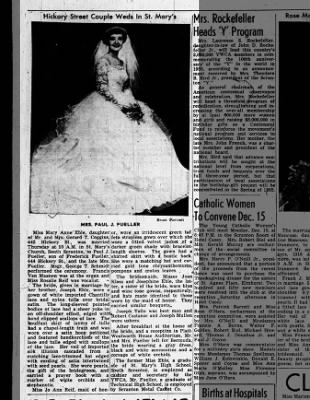

Marie L. Judge married John L. Prendergast Jr. on Saturday, Nov. 26, 1949, in St. Joseph’s Church, Scranton.
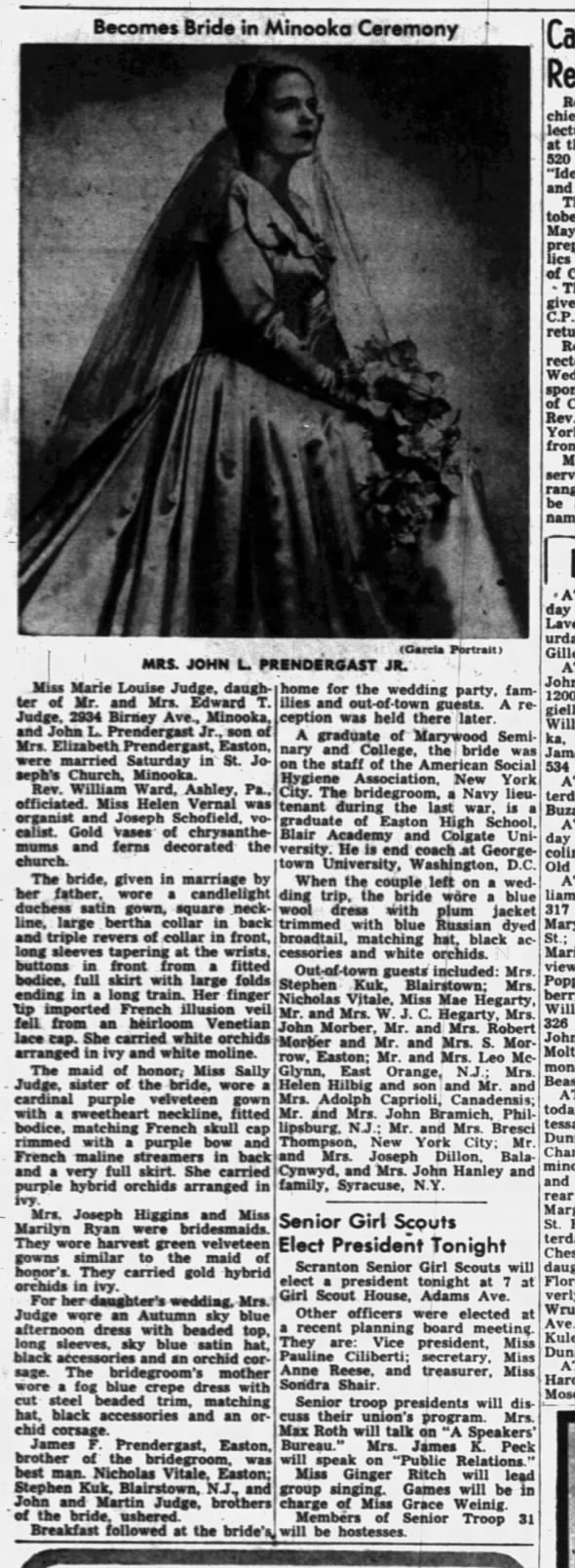
Elaine Sofranko married George Cameli on Saturday, Aug. 4, 1956, in St. John the Baptist Church, Throop.
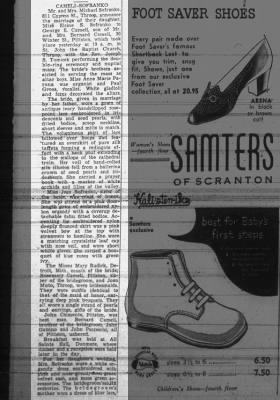

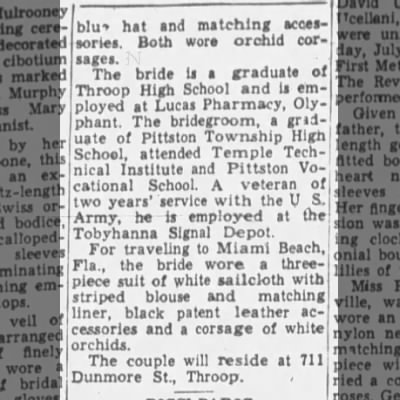

Mr. and Mrs. John E. Wilson celebrated their 60th wedding anniversary on Saturday, March 27, 1926, with a dinner at the Van Gordon tea room, Moscow, and a service on Sunday morning.




Laura Rysz is the features copy editor and calendar editor at The Times-Tribune and runs the Talk of the Times column, which focuses on local fundraisers and other events. She also writes Chef’s Table that profiles restaurants around the region. Additionally, Laura curates events online on AccessNEPA.com. Laura is involved in the special Mother’s Day edition and curates occasional features Marry Memories and Times Travelers. She is a graduate of Haddonfield Memorial High School, New Jersey, and earned an English professional writing degree with a minor in mass communications from King’s College, Wilkes-Barre. She also earned a certificate in Social Media Marketing from Rutgers Business School. Contact: lrysz@timesshamrock.com; 570-348-9100 x5228.
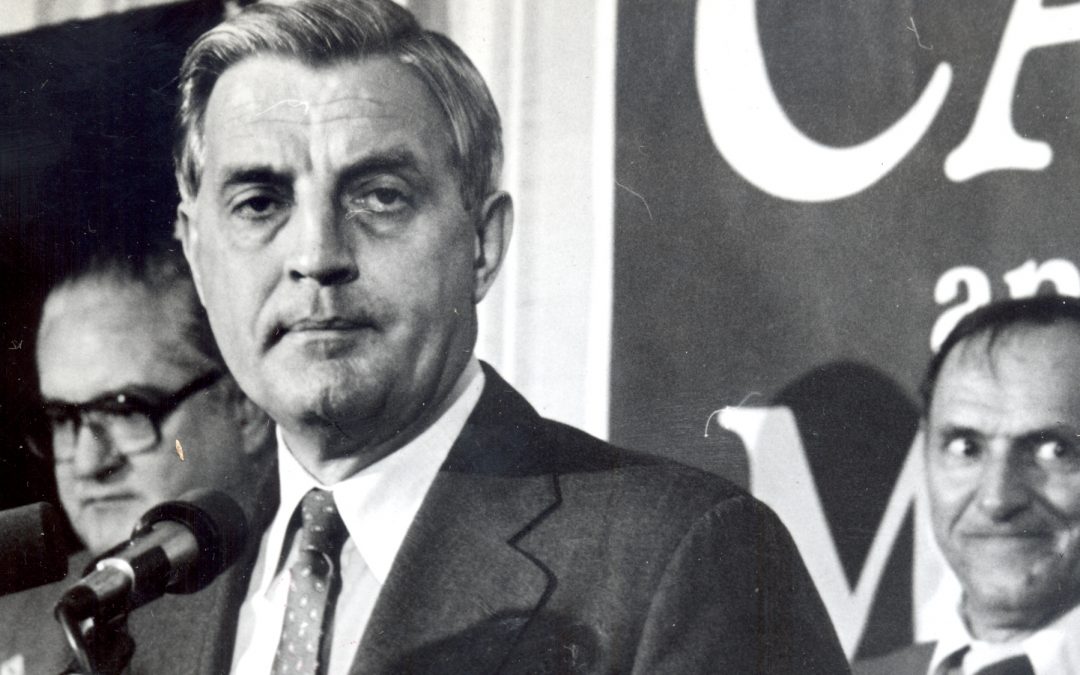

Remembering Walter Mondale
Former Vice President Walter Mondale died on Monday, April 19, 2021 at his home in Minneapolis at the age of 93.
In today’s Times-Tribune, staff writer David Singleton wrote about local politicians memories of meeting the former vice-president, one-time democratic presidential nominee and former Ambassador to Japan.
Here are few images from the Times-Tribune Archives of Mondale’s visits to Scranton and Wilkes-Barre over the years.
- Vice President Walter Mondale is flanked by Scranton Mayor Eugene Hickey, left, and Wilkes-Barre Mayor Thomas McLaughlin during campaign stop at the Operating Engineers Temple in Plains Twp. on Sept. 15, 1980. Some 600 local union members were in attendance for the visit. TIMES-TRIBUNE ARCHIVES
- Scrantn Mayor Eugene Hickey, background, looks on as Vice President Walter Mondale speaks to students at Scranton Central High School on April 21, 1980. The vice president was here to push President Carter’s re-election bid. TIMES-TRIBUNE ARCHIVES
- Vice President Walter Mondale answers questions during a press conference at the Wilkes-Barre/Scranton International Airport on Oct. 30, 1980. TIMES-TRIBUNE ARCHIVES
- Vice President Walter Mondale does the honors as he introduces Atty. Robert P. Casey Sr. of Scranton, center, to a supporter during his whirlwind tour of the Wyoming Valley on April 14, 1980. Casey was the chairman of Pennsylvanians for Carter-Mondale. TIMES-TRIBUNE ARCHIVES
- Vice President walter Mondale had a big smile and wave for those who greeted him on April 14, 1980 at his arrival at the Wilkes-Barre/Scranton International Airport for a campaign swing on behalf of President Jimmy Carter. To his left is former U.S. Rep. Daniel Flood and U.S. Rep.-Elect Ray Musto. TIMES-TRIBUNE ARCHIVES
- Democratic presidential candidate Walter Mondale gives a thumbs-up victory salute to cheering admirers at Public Square in Wilkes-Barre during a campaign stop on Nov. 2, 1984. Police estimated the rally’s crowd size to between 8,000 to 10,000. TIMES-TRIBUNE ARCHIVES
- Walter Mondale, Democratic presidential candidate, left-center, greets well-wishers and party faithful who gathered at Courthouse Square on April 9, 1984 as the former vice-president continued his tour of Pennsylvania prior to the state’s presidential primary on April 10. TIMES-TRIBUNE ARCHIVES
- Scranton Mayor James B. McNulty gives presidential candidate Walter Mondale the glad hand at a rally in Wilkes-Barre on Nov. 2, 1984. Lackawanna County Commissioner Ray Alberigi is partly obscurred by Mondale as Pittston Mayor Thomas Walsh reaches for the Democratic hopeful. At right is attorney Michael Cefalo. TIMES-TRIBUNE ARCHIVES
- Walter Mondale, who is seeking to become president, tries his hand at cutting material during a campaign stop at the Leslie Fay garment factory in Plains Twp. on April 9, 1984. Looking on at left are John Pomerantz and Jim Simko, the real cutter. TIMES-TRIBUNE ARCHIVES
- U.S. Sen. Walter Mondale, right, attempts to shake hands of potential voters when he arrived at the Wilkes-Barre/Scranton International Airport on Oct. 26, 1976. TIMES-TRIBUNE ARCHIVES
Related:
Geraldine Ferraro, vice presidential candidate visit made history in early 1980s – Nov. 1, 2020










Brian Fulton has been the librarian at The Times-Tribune for the past 15 years. On his blog, Historically Hip, he writes about the great concerts, plays/musicals and celebrity happenings that have taken place throughout NEPA. He is also the co-host of the local history podcast, Historically Hip. He competed and was crowned grand champion on an episode of NPR quiz show “Ask Me Another.” Contact: bfulton@timesshamrock.com; 570-348-9140; or @TTPagesPast
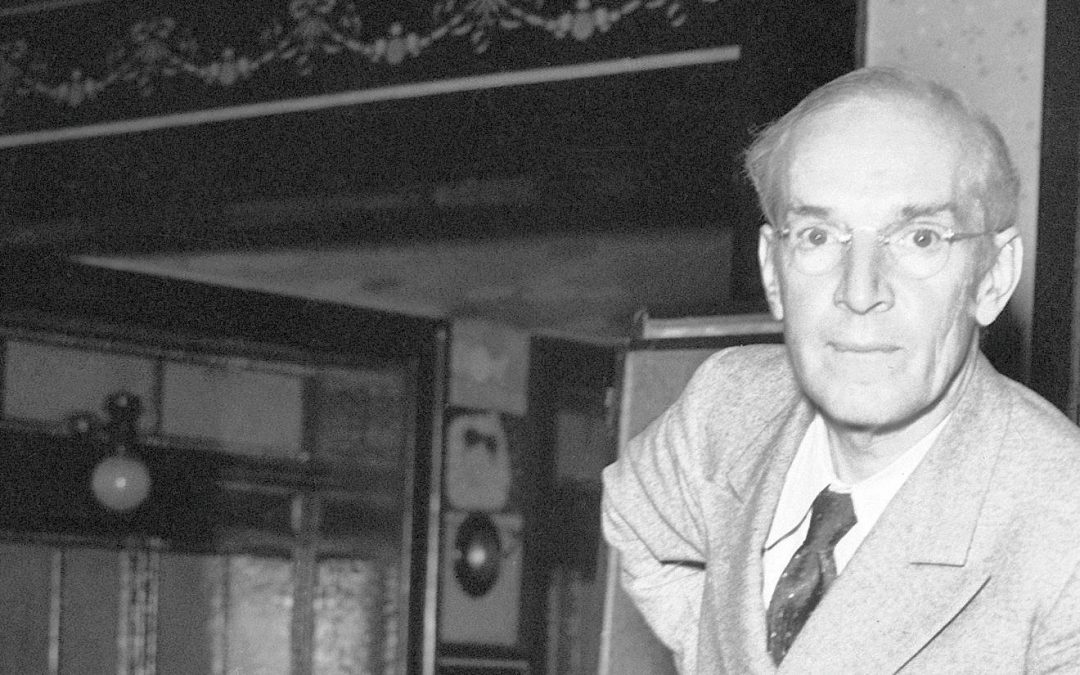

Time Warp – ‘The Jungle’ puts Sinclair, meatpacking industry in spotlight
Editor’s note: In the weeks leading up to the 93rd Academy Awards ceremony on Sunday, April 25, Time Warp will feature stories related to films nominated this year and other local connections to the annual film event.
1906: In the Academy Award-nominated film “Mank,” writer, activist and 1934 California gubernatorial candidate Upton Sinclair has a minor but important part that deals with the writing of the screenplay for “Citizen Kane.” Bill Nye – yes, Bill Nye the Science Guy – plays Sinclair opposite Charles Dance as newspaper magnate William Randolph Hearst, Arliss Howard as Louis B. Mayer and Ferdinand Kingsley as Irving Thalberg.
Sinclair was well-known by then, having entered the spotlight in 1906 with his book, “The Jungle.” Sinclair worked in the meatpacking industry in Chicago to get background for this work of fiction, which was first serialized in the socialist newspaper “Appeal to Reason” and later published in book form by Doublebay.
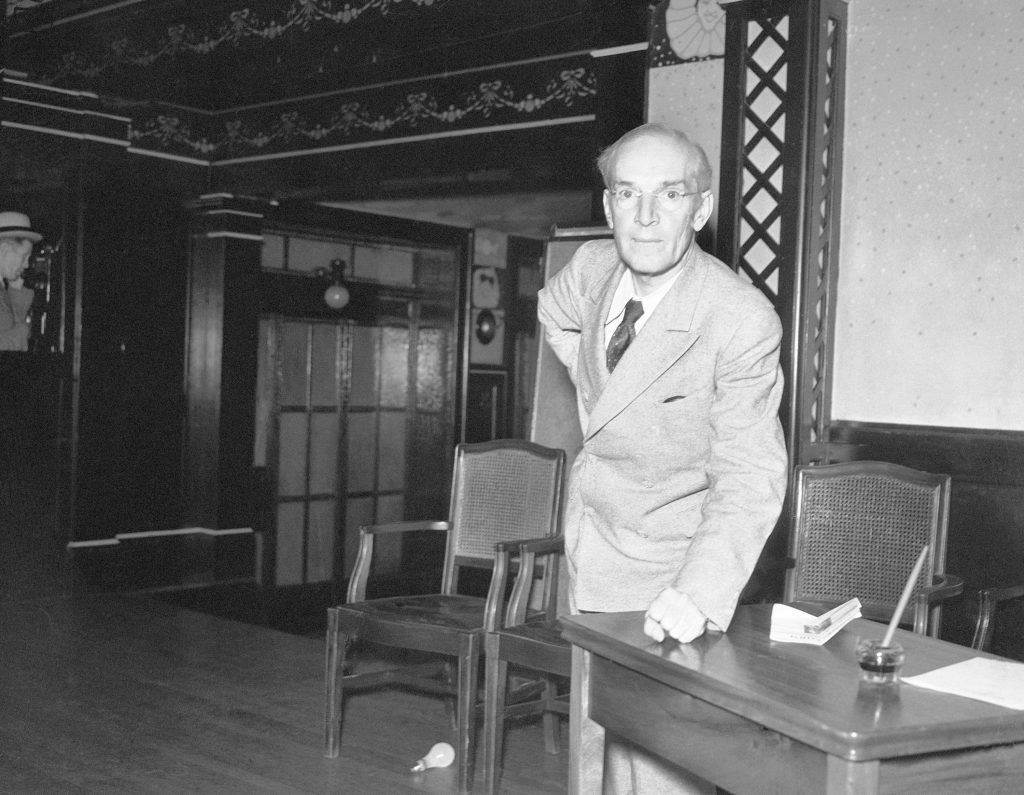

Upton Sinclair is shown in California on Oct. 24, 1934. (AP Photo)
The book focuses on a Lithuanian immigrant, Jurgis Rudkus, who works in a meatpacking plant. The reader goes on a journey through the unsafe, unethical and unsanitary conditions that the mostly immigrant workforce faced in the Windy City’s plants. It also touches on the workers’ lives outside the factory and what is was like to be the working poor.
When the book hit the streets in February 1906, it created as a stir. On March 17, a short article in the Scranton Republican traced the early career of Sinclair up to his work on “The Jungle.” The newspaper reporter called the novel “the most daring and remarkable book that has been published in this country.”
A month later, in the Literary Notes section of the Scranton Republican, a report noted that the book saw “wide sales” and that newsdealers constantly were requesting more copies.
“It may be called a blazing indictment of conditions as they exist there, yet if all is true that Sinclair in his novel says, the government should not lose a minute to step in and right some of the terrible wrongs that are being perpetrated there,” the reporter said of the book.
The federal government did step in.
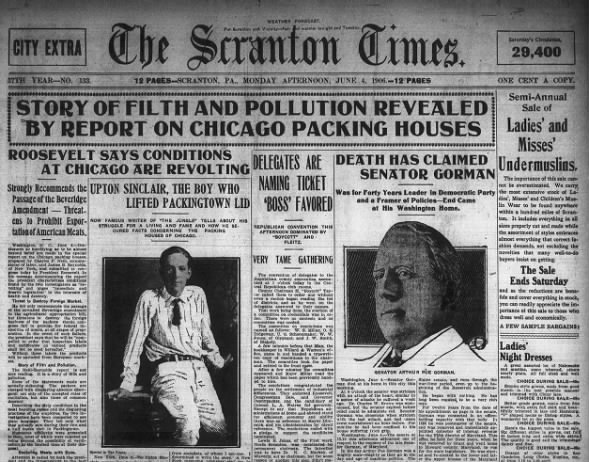
In the June 4, 1906, edition of the Scranton Times, an article dealt with an investigation of the meatpacking industry ordered by President Theodore Roosevelt. The president described what his investigators, Labor Commissioner Charles Neill and social worker James Reynolds, uncovered as revolting.
Roosevelt called for “immediate and drastic legislation in the interests of health and decency.” By the end of the month, Congress had passed the Meat Inspection Act and the Pure Food and Drug Act.
Sinclair continued writing, trying to affect change with his prose. He took on the newspaper industry (“The Brass Check”), coal mining (“King Coal”), oil drilling (“Oil!”) and the automobile industry (“The Flivver King”).
Sinclair entered politics in 1920, first running for a seat in the U.S. House of Representatives; the U.S. Senate in 1922; and three times for governor of California, in 1926, 1930 and 1934.
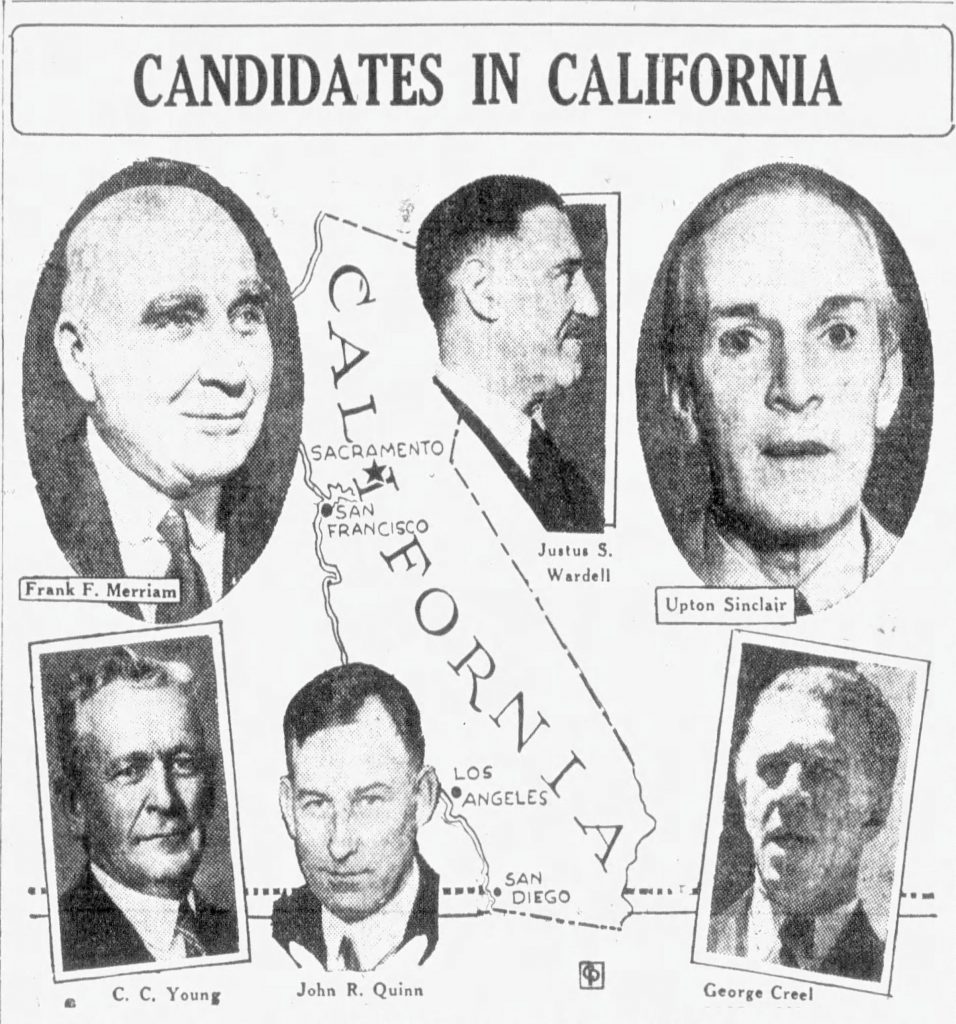

Photo illustration and map from the Aug. 25, 1934 edition of the Scranton Times dealing with the candidates running for governor in California. Republicans candidates were Gov. Frank Merriam, former governor C.C. Young, and John R. Quinn. The democratic candidates were author Upton Sinclair, writer George Creel and Justus S. Wardell.Sinclair and Merriam would capture their party’s nominations on Aug. 28, 1934. Submitted Material
In his 1934 gubernatorial run, depicted in the film “Mank,” he received no support from newspapers in California. Hearst, a major character in “Mank,” owned newspapers in Los Angeles, Oakland and San Francisco, according to a newspaper guide from the University of Illinois Library.
The Hollywood studios were not fans of Sinclair, either. His run fell victim to the “first big ‘hit campaign’ of modern politics, spearheaded in no small part by the Hollywood studios, and in particular, MGM, Irving Thalberg, and studio head Louis B. Mayer,” according to a 2016 KCET.com article. MGM even produced fake newsreels called “California Election News” with the intent to move voters’ opinions away from Sinclair.
Sinclair ran on a platform of ending poverty in California. He suggested having unemployed people use empty factories to make goods for their own use, giving the unemployed land so they could grow produce, providing pensions for blind and disabled people, getting rid of California’s sales tax and adding a graduated state income tax.
In the end, Sinclair lost to incumbent Republican Gov. Frank Merriam in the general election, but he continued writing. He won the Pultizer Prize for Fiction in 1943 for his work “Dragon Teeth,” which deals with the rise of Nazi Germany in the 1930s.
Sinclair died at 90 at a nursing home in Bound Brook, New Jersey. His obituary in the Scranton Times on Nov. 26, 1968, called him the “king of the muckrakers.”
Related –
Mankiewicz brothers leap from Wilkes-Barre into Hollywood history – Dec. 7, 2020
‘Chicago 7’ members follow trial with local visits to universities – April 8, 2021
Remembering Louis Weitzenkorn – Jan. 12, 2020










Brian Fulton has been the librarian at The Times-Tribune for the past 15 years. On his blog, Historically Hip, he writes about the great concerts, plays/musicals and celebrity happenings that have taken place throughout NEPA. He is also the co-host of the local history podcast, Historically Hip. He competed and was crowned grand champion on an episode of NPR quiz show “Ask Me Another.” Contact: bfulton@timesshamrock.com; 570-348-9140; or @TTPagesPast


Remembering Prince Philip
Prince Philip, the Duke of Edinburgh, died peacefully today, April 9, at Windsor Castle according to announcement made by Queen Elizabeth II released by Buckingham Palace. He was 99.
Philip was born June 10, 1921 on the island of Corfu to Prince Andrew of Greece and Denmark and Princess Alice of Battenberg. Philip attended school in England and enrolled in the Britannia Royal Naval College Dartmouth in 1939 and an year later he was in the service of the Royal Navy. In 1947, his engagement to Princess Elizabeth was announced and the pair were married on Nov. 20.
Here are few items for our archives dealing with Prince Philip.
- Short front page news item from the Mar. 25, 1947 edition of the Scranton Times announcing that Philip had been granted British citizenship and had taken the last name of his cousin, Lord Mountbatten. Times-Shamrock Archives
- A short editoiral from the April 21, 1947 edition of the Scranton Times dealing with the courtship of Elizabeth and Philip. Times-Shamrock Archives


An article from the July 10, 1947 edition of the Scranton Times dealing with the engagement of Princess Elizabeth to Philip. Times-Shamrock Archives
- Article about the royal wedding of Princess Elizabeth to Philip, the Duke of Edinburgh, from the Nov. 20, 1947 edition of the Scranton Times. Times-Shamrock Archives
- Article about the royal wedding of Princess Elizabeth to Philip, the Duke of Edinburgh, from the Nov. 20, 1947 edition of the Scranton Times. Times-Shamrock Archives
- This is the official wedding picture of Princess Elizabeth and her new husband Prince Philip,Duke of Edinburgh, made after their return to Buckingham Palace after their marriage in Westminster Abbey, Nov. 20, 1947. (AP Photo)
- Britain’s Queen Elizabeth II and her husband the Duke of Edinburgh wave to the crowd from the balcony of Buckingham Palace, London, Nov. 20, 1947. From left to right, King George VI, Princess Margaret, Lady Mary Cambridge, the bride and bridegroom, Queen Elizabeth and Queen Mary. (AP Photo)
Further Reading and Viewing –
Prince Philip, husband of Queen Elizabeth II, dies at 99 – Associated Press
Prince Philip had died aged 99, Buckingham Palace announces – BBC News










Brian Fulton has been the librarian at The Times-Tribune for the past 15 years. On his blog, Historically Hip, he writes about the great concerts, plays/musicals and celebrity happenings that have taken place throughout NEPA. He is also the co-host of the local history podcast, Historically Hip. He competed and was crowned grand champion on an episode of NPR quiz show “Ask Me Another.” Contact: bfulton@timesshamrock.com; 570-348-9140; or @TTPagesPast
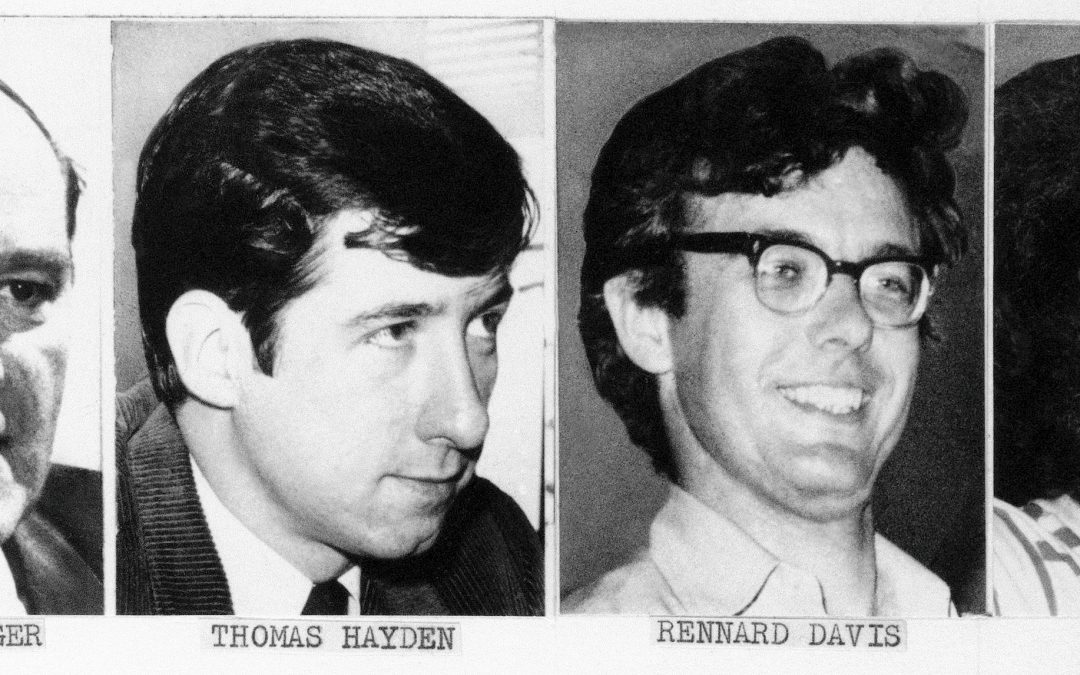

Time Warp – ‘Chicago 7’ members follow trial with local visits to universities
Editor’s note: In the coming weeks leading up to the 93rd Academy Awards ceremony on Sunday, April 25, Time Warp will feature stories related to films nominated this year or other local connections to the annual film event.
1968: “The Trial of the Chicago 7” takes the viewer back to the turbulent times of the late 1960s when a group of political activists planned to protest at the 1968 Democratic National Convention in Chicago. Later, the group was arrested and charged, forever becoming known as the Chicago 7.
Originally, there were eight co-defendants – Abbie Hoffman, Jerry Rubin, Tom Hayden, Rennie Davis, David Dellinger, Lee Weiner, John Froines and Bobby Seale – but as the trial moved forward, Seale was removed from the case.
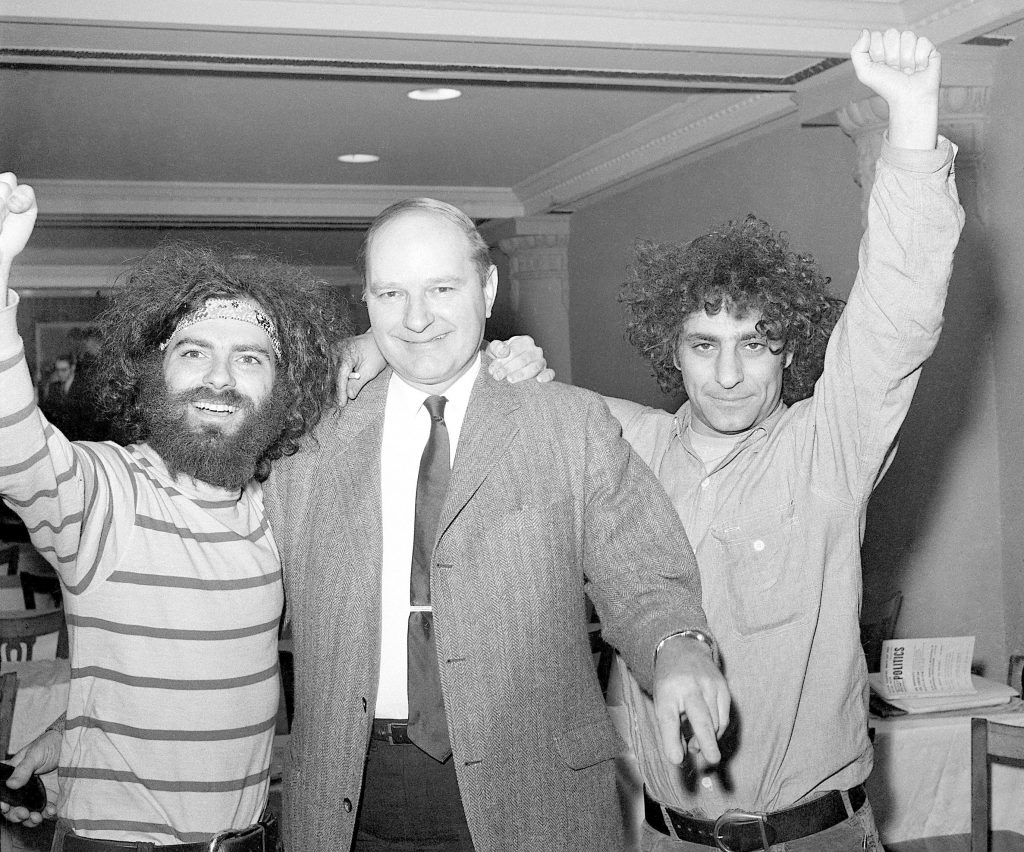

Jerry Rubin, David T. Dellinger and Abby Hoffman at a press conference in New York on March 21, 1969. They face indictment charges on inciting to riot, in Chicago. (AP Photo/Robert Kradin)
Over the years, three men associated with this case visited Scranton to lecture at local colleges and universities. The first to visit was David Dellinger on Sept. 28, 1970. The longtime pacifist also was the co-chairman of the New Mobilization Committee to End the War in Vietnam. His talk was held at University of Scranton’s Long Center and was sponsored by the university’s lecture series committee. The lecture was free and open to the public.
Second to visit was political and social activist Abbie Hoffman, who spoke before 700 students at University of Scranton’s student center on Oct. 14, 1986. During his hour-long talk, Hoffman spoke on a variety of topics, such as the United States’ invasion of Nicaragua in 1912, the Vietnam War, the CIA, South Africa, the “Star Wars” program and televangelists Jimmy Swaggart and Jerry Falwell.
He said the 1912 invasion of Nicaragua “was the heyday of Yankee imperialism” and called the Vietnam War “an illegal, stupid, unwinnable war caused by a bully country picking on a small country.” He reminded those in attendance that Dr. Edwin Teller, the father of the “Star Wars” program, inspired the role of Dr. Strangelove in the film of the same name.
During a press conference following the lecture, an unidentified man asked Hoffman, who was also known as a jokester, if he ever changes his mind. Hoffman responded, “I changed my underwear.”
The third visit was from Bobby Seale on Feb. 3, 2000. Seale was the surviving founder, former chairman and national organizer of the Blank Panther Party. His lecture was part of Penn State Worthington Scranton’s campus lecture series. Seale spoke about how his desire to learn more about African and African American history as a young man led him to form the Black Panther Party with Huey P. Newton, and that the history not taught in schools inspired him.
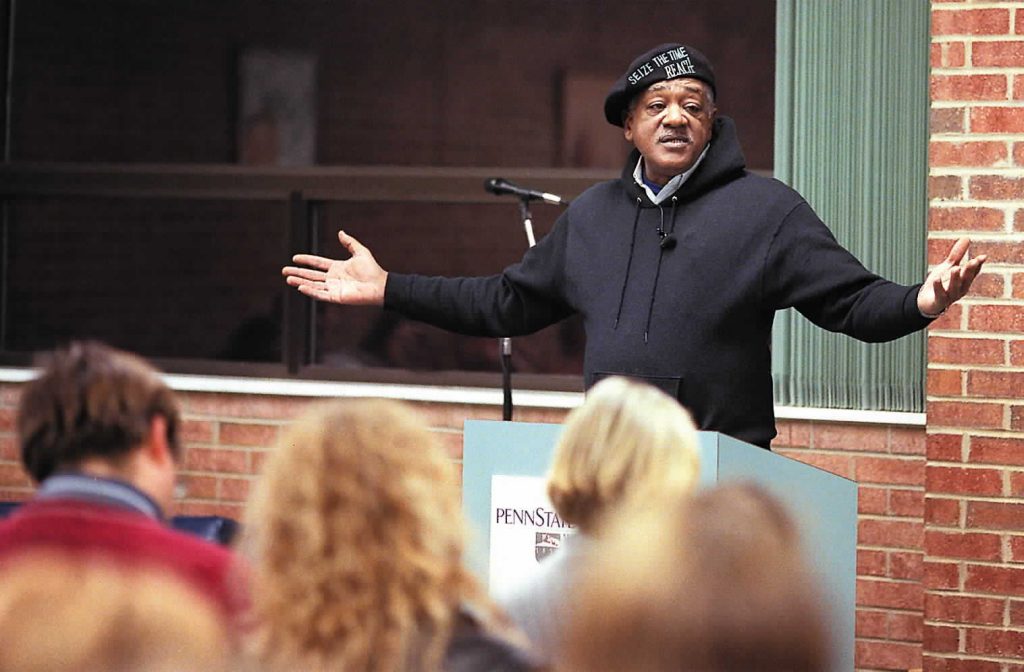

Black Panther co-founder Bobby Seale speaks at Penn State Scranton on Feb. 3, 2000, as part of the university’s lecture series to mark Black History Month. TIMES-TRIBUNE FILE
Seale also addressed why members of the party carried guns during peaceful protests of the Oakland Police Department.
“Peaceful protesters were being jumped on and shot up in the early and late ’60s,” he said. “Racists got away with killing us. Huey’s argument was, if peaceful protesters were exercising their rights, then we don’t support the politicians who send the police down to take those rights away. That’s where we were coming from. That’s what the guns were about.”
In the film, John Carroll Lynch plays Dellinger, Sacha Baron Cohen portrays Hoffman, and Yahya Abdul-Mateen II plays Seale. The film is nominated for six Academy Awards: best picture, Sacha Baron Cohen for best supporting actor, Aaron Sorkin for best original screenplay, Phedon Papamichael for best cinematography, Daniel Pemberton and Celeste for best original song for “Hear My Voice” and Alan Baumgarten for best film editing.
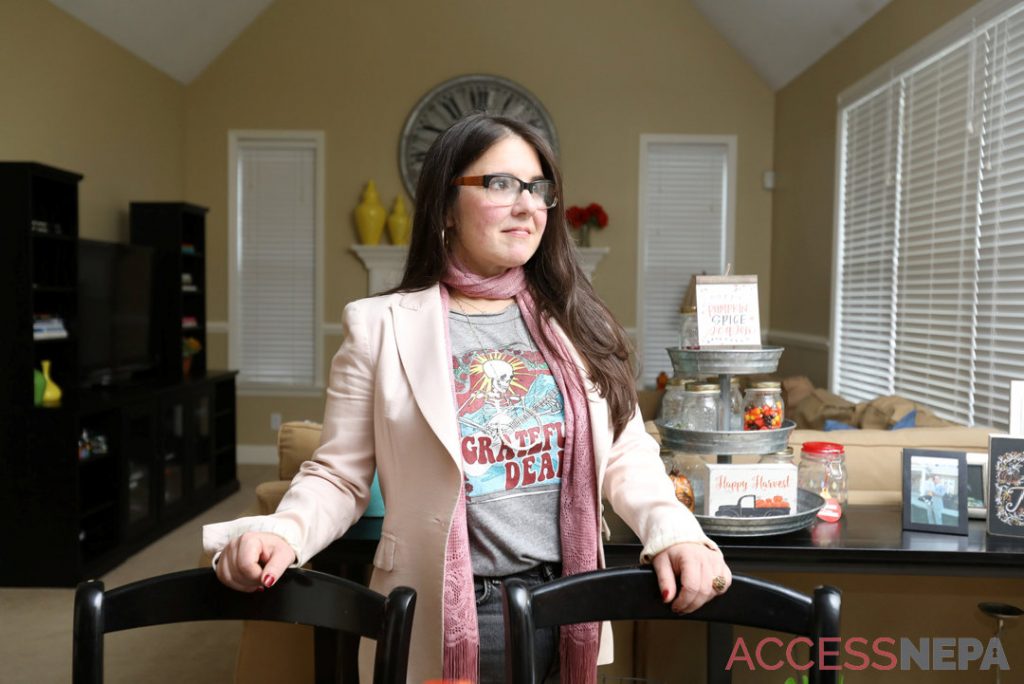

JAKE DANNA STEVENS / STAFF PHOTOGRAPHER Old Forge native Mia Cusumano, who now lives and works in NYC as a successful casting director for numerous TV shows and movies that attract big-name talents.
Old Forge native Mia Cusumano meanwhile, played an integral role in “The Trial of the Chicago 7.” Part of the casting team for the film, Cusumano is nominated with her coworkers in the Artios Awards, presented by the Casting Society of America, in the category of big budget – drama film. The Artios ceremony will be held virtually on Thursday, April 15.










Brian Fulton has been the librarian at The Times-Tribune for the past 15 years. On his blog, Historically Hip, he writes about the great concerts, plays/musicals and celebrity happenings that have taken place throughout NEPA. He is also the co-host of the local history podcast, Historically Hip. He competed and was crowned grand champion on an episode of NPR quiz show “Ask Me Another.” Contact: bfulton@timesshamrock.com; 570-348-9140; or @TTPagesPast


Time Warp – Marywood students show off their designs at fashion show
Dec. 15, 1952: Sixty-six students in Marywood College’s home economics department showed why fashion is hard work.
The freshmen and sophomores in the clothing course had to select outfit patterns, shop for material and construct items. They produced an array of coats, suits and dresses for holiday gatherings, while juniors in the course had to design and construct a gown.
All of the creations were modeled at a pre-holiday fashion show held in the Marywood Theater with the theme “Christmas in New York.” The stage was dressed with decorated Christmas trees and a black velvet backdrop.
- Jeanne Mullaney, of Scranton, models an outfit she made for her clothing course at Marywood College in the fall of 1952. TIMES-SHAMROCK ARCHIVES
- Alice Murrary, of Elmira, New York, models an outfit she made for her clothing course at Marywood College in the fall of 1952. TIMES-SHAMROCK ARCHIVES
- Mary Blewitt, of Scranton, models an outfit she made for her clothing course at Marywood College in the fall of 1952. TIMES-SHAMROCK ARCHIVES
- Mary Lou Roe, of Olyphant, models an outfit she made for her clothing course at Marywood College in the fall of 1952. TIMES-SHAMROCK ARCHIVES
Some of the coursework that hit the runway that day included a cinnamon sueded wool coat dress from Jeanne Mullaney of Scranton; a tailored charcoal gray flannel jacket and a gray skirt from Mary Lou Roe of Olyphant; a poodle cloth princess coat from Mary Blewitt of Scranton; and a wine-colored wool dress from Alice Murray of Elmira, New York, that had a crinoline to give the outfit a “great swoosh of skirt designed to flirt merrily through holiday gatherings.”
The purpose of the clothing course was to teach the young women “that fashion is one part scientific construction, one part skilled hands that have painstaking acquired a way with the cloth and one part individuality.”
Working it for the camera
Using the app Deep Nostalgia (https://www.myheritage.com/deep-nostalgia) I was able to animate our four models. Here are the images –
Mary Lou Roe, of Olyphant, models an outfit she made for her clothing course at Marywood College in the fall of 1952. TIMES-SHAMROCK ARCHIVES/Animation by Deep Nostalgia
Mary Blewitt, of Scranton, models an outfit she made for her clothing course at Marywood College in the fall of 1952. TIMES-SHAMROCK ARCHIVES/Animation by Deep Nostalgia
Alice Murrary, of Elmira, New York, models an outfit she made for her clothing course at Marywood College in the fall of 1952. TIMES-SHAMROCK ARCHIVES/Animation by Deep Nostalgia
Jeanne Mullaney, of Scranton, models an outfit she made for her clothing course at Marywood College in the fall of 1952. TIMES-SHAMROCK ARCHIVES/Animation by Deep Nostalgia










Brian Fulton has been the librarian at The Times-Tribune for the past 15 years. On his blog, Historically Hip, he writes about the great concerts, plays/musicals and celebrity happenings that have taken place throughout NEPA. He is also the co-host of the local history podcast, Historically Hip. He competed and was crowned grand champion on an episode of NPR quiz show “Ask Me Another.” Contact: bfulton@timesshamrock.com; 570-348-9140; or @TTPagesPast
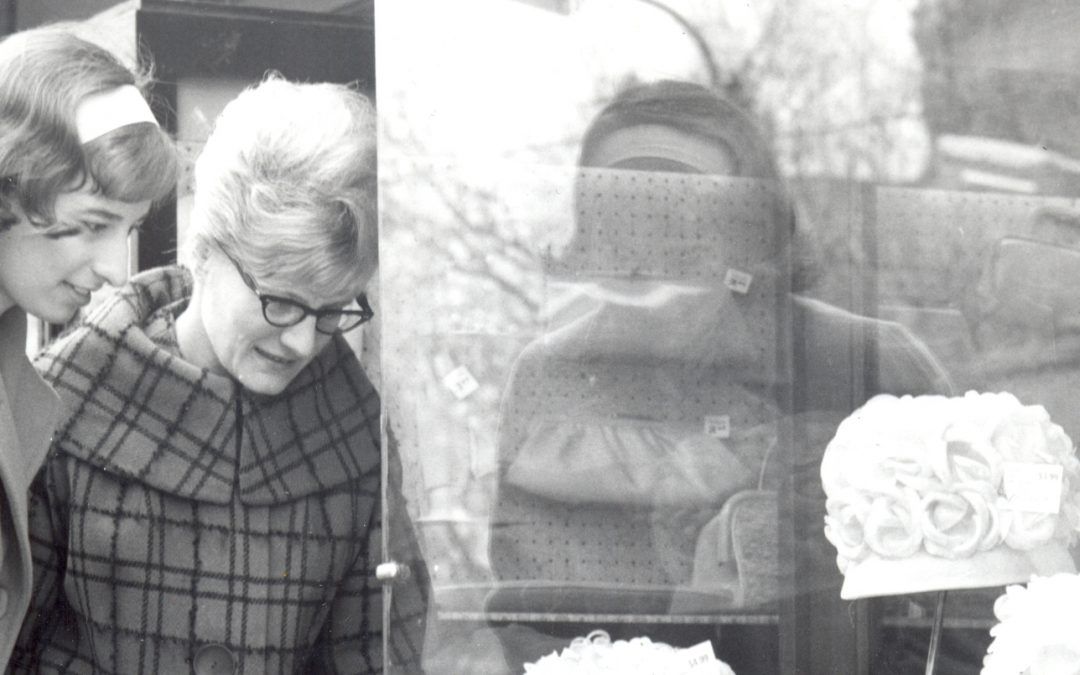

Throwback Thursday – Getting Ready for Easter
On April 17, 1965 downtown Scranton was filled with folks getting last minute items in preparation for the Easter Sunday celebrations the next day.
Here are three images from our archives from that Saturday.


An unidentified woman checking out Easter lillies at a floral stand on Apr. 17, 1965 in downtown Scranton. TIMES-SHAMROCK ARCHIVES


Two unidentified women doing a little window shopping on April 17, 1965 in downtown Scranton. TIMES-SHAMROCK ARCHIVES


Unidentified shoppers and pedestrians crossing Wyoming Avenue along the 300 block of Lackawanna Avenue on April 17, 1965 in downtown Scranton. TIMES-SHAMROCK ARCHIVES
Keep an eye out for more images from Easter 1965 in the Sunday Times on April 4.










Brian Fulton has been the librarian at The Times-Tribune for the past 15 years. On his blog, Historically Hip, he writes about the great concerts, plays/musicals and celebrity happenings that have taken place throughout NEPA. He is also the co-host of the local history podcast, Historically Hip. He competed and was crowned grand champion on an episode of NPR quiz show “Ask Me Another.” Contact: bfulton@timesshamrock.com; 570-348-9140; or @TTPagesPast
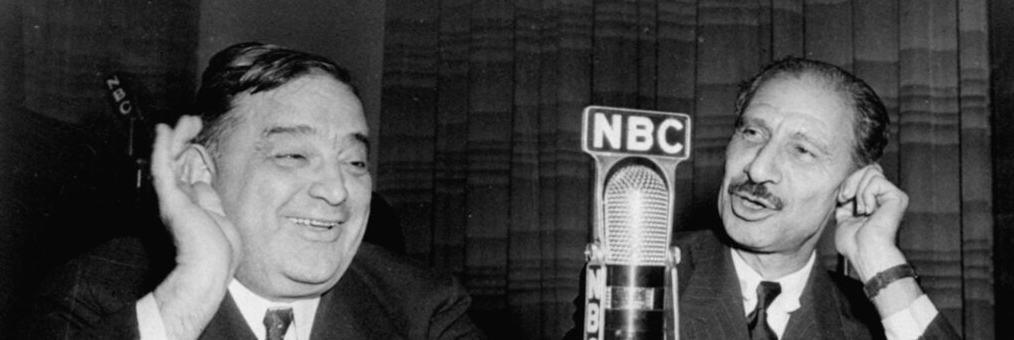

TIme Warp – Audiences pack Masonic Temple for musical ‘Fiorello!’
March 4, 1961: It was standing-room only for the first of two performances of “Fiorello!” at the Masonic Temple in Scranton.
The biographical musical about the life of late New York City Mayor Fiorello La Guardia was the final show for the Broadway Theatre League’s 1960-61 season. It opens with his run for Congress against the Tammany Hall political machine, which happened prior to the United States entering World War I and La Guardia’s return home from that war. The second act deals with his run for mayor against Jimmy Walker and the plot to kill La Guardia that emerges. The theme of how La Guardia’s political world affects his friends and love life runs throughout the musical.
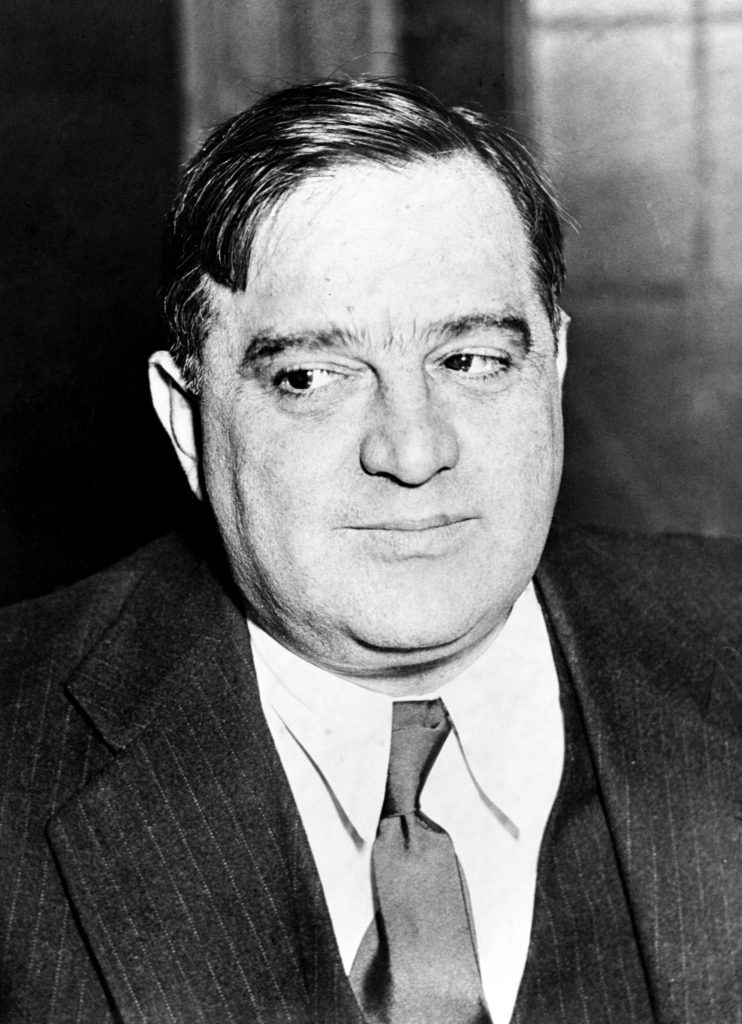

A portion of the life of Fiorello Henry LaGuardia was portrayed in the Broadway musical “Fiorello!” The musical opens in July 1945 while Fiorello is reading the comics over the radio during a newspaper delivery strike. Associated Press File Photo
In 1960, “Fiorello!” won the Pulitzer Prize for drama and the New York Drama Critics Award, and it shared the Tony Award for best musical with “The Sound of Music.” At the time the show played Scranton, which included a second performance on March 5, it was still on Broadway at the Broadhurst Theatre.
Bob Carroll, who was a soloist in the Jimmy Dorsey band, played the role of Fiorello in Scranton. Other members of the cast included Paul Lipson as Morris, Zeme North as Dora, Charlotte Fairchild as Marie, Rudy Bond as Ben, Clint Young as Floyd and Jen Nelson as Thea.
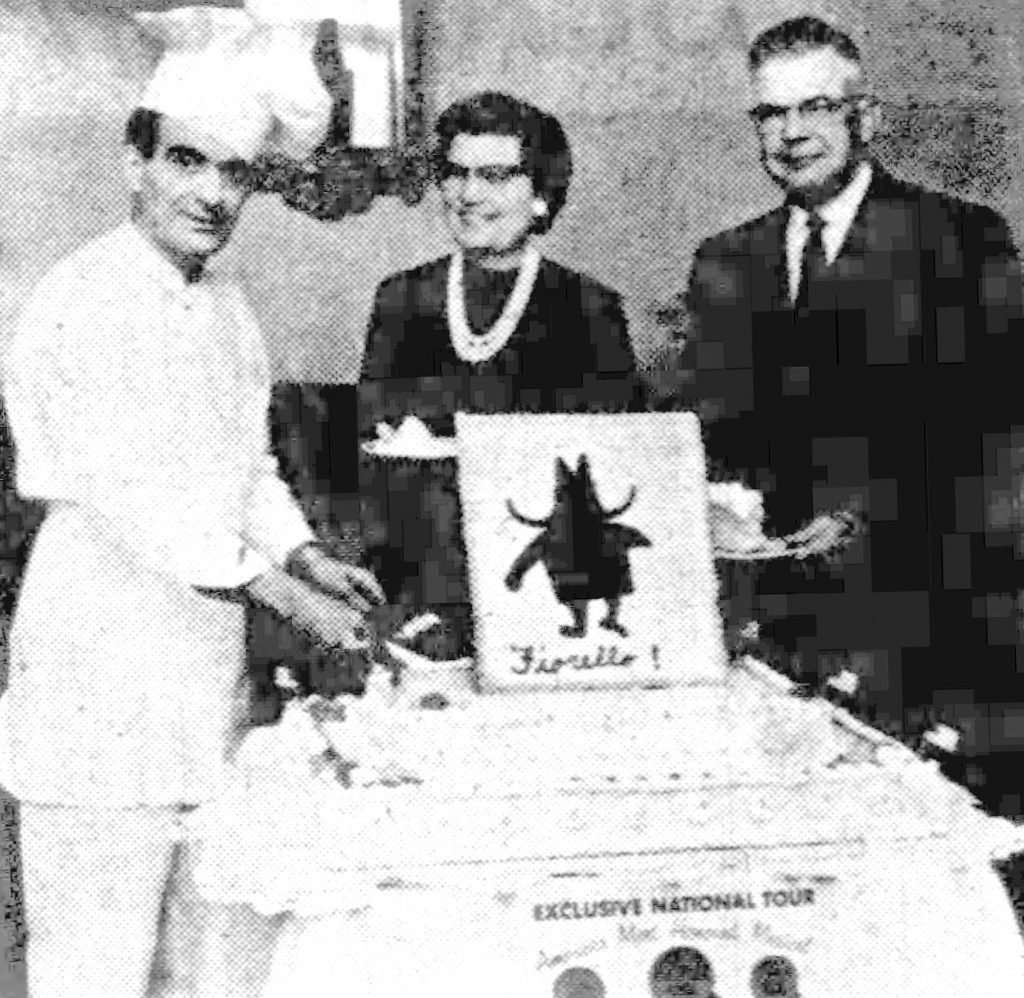

Cake promoting presentation of “Fiorello!” on March 4 and 5, 1961 at the Masonic Temple was on display at the Hotel Jermyn, where the cast of the touring production were staying. From left: Chef Dino Galli, Elvira R. Berry, secretary of Broadway Theater League of Scranton, sponsor of the production, and George H. Evans, treasurer. The cake will be served to the members of the cast. TIMES-SHAMROCK ARCHIVE
The Hotel Jermyn also joined in the excitement of live musical theater in Scranton by offering its famous dinner buffet on March 4 and 5 prior to curtain time. The buffet cost $3.50.
The cast also stayed at the Hotel Jermyn. To celebrate the show and cast, the hotel’s bakers created a “Fiorello”-themed cake that was presented to the cast.
Proceeds from Broadway Theatre League’s season were earmarked as a donation to the Lackawanna United Fund (now the United Way of Lackawanna and Wayne Counties). The other shows in the 1960-61 season were “Once Upon a Mattress,” “The Andersonville Trial” and “The Pleasure of His Company.”
Song ‘Politics and Poker’ from the musical “Fiorello!”
New York City Mayor Fiorello LaGuardia reading the comics over the radio during the 1945 newspaper deliverymen strike.










Brian Fulton has been the librarian at The Times-Tribune for the past 15 years. On his blog, Historically Hip, he writes about the great concerts, plays/musicals and celebrity happenings that have taken place throughout NEPA. He is also the co-host of the local history podcast, Historically Hip. He competed and was crowned grand champion on an episode of NPR quiz show “Ask Me Another.” Contact: bfulton@timesshamrock.com; 570-348-9140; or @TTPagesPast

